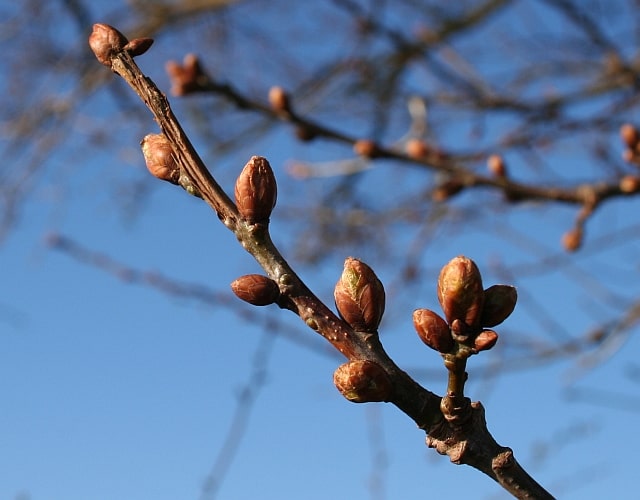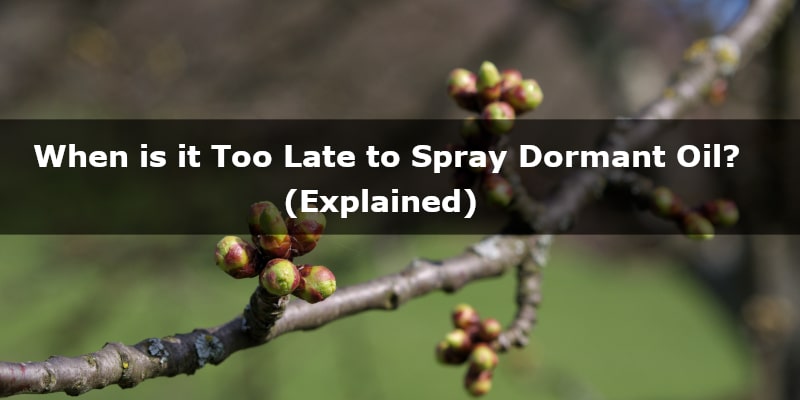So, you want to spray dormant oil on your trees, but don’t know if it’s not too late?
In this article, you will learn when it’s too late to spray dormant oil, and what will happen if you don’t do it.
What’s the Role of Dormant Oil?
The role of dormant oil is to control the insect pests on plants, usually on trees. Dormant oil suffocates insects and their eggs nesting in branches by penetrating into the surface of the insect’s hard outer shell and not allowing any oxygen to get through. By spraying leaf and limb surfaces, you drastically limit the population of insects.
Dormant oil kills insects because it contains toxic to them refined from petroleum oil, such as mineral oil, captan, malathion, and cabaryl.
The insects that dormant oil works on are:
- Aphids
- Mealybugs
- Thrips
- Whiteflies
- Scale
- Mites
- Leafhoppers
- Caterpillar eggs
- Adelgids
…and many more.
Dormant oil can be used on many plants, including apple trees, cherries, grapes, plum, strawberries, pear, gooseberry, currant bushes, or flowers. Dormant oil might damage these plants when they start flowering, so applying it when they’re still dormant is the way to go.
When is the Best Time to Spray Dormant Oil?
Dormant oil should be applied in late winter, or early spring when the plants are still dormant, but before the buds begin to swell. It should be applied when the temperatures are just above freezing-at least 40 degrees F. (4 C.)
Usually, it’s recommended to apply dormant oil in late March, or early April, just before the plants show signs of breaking dormancy. Dormant oil sprays should be applied as close to bud break as possible to ensure the highest effectiveness. As a rule of thumb, the best time to apply dormant oil is 3-7 days before bud break.
Applying dormant oil earlier in the winter, for example in early March, or February is not recommended. During this time, insects are not actively respiring, and aren’t vulnerable to the oil’s suffocating effects.
When is it Too Late to Spray Dormant Oil?
In general, applying dormant oil in mid, or late April is too late. However, every plant breaks dormancy at a different time. As a rule of thumb, applying dormant oil after bud break is a sign that it’s already too late, and it might injure your tree or other plant.
It’s not so easy to spray dormant oil at the right moment. A lot depends on the weather conditions and the type of tree. You should know that it’s better to do it earlier than too late.
If you spray dormant oil too early, you risk the fact that it might not work, because insects aren’t respiring yet. However, if you spray dormant oil too late, you not only let the insects hatch from eggs, but you also risk the injury of your tree.
So, as a rule of thumb, if you see the buds are starting to break, it’s too late to spray dormant oil. If the buds are already swelling, but aren’t breaking yet, you still can apply dormant oil. However, using dormant oil in a normal ratio isn’t recommended. You should decrease the ratio of dormant oil that you mix with water by 50%.
For example, if the manufacturer recommends mixing 2,5 tablespoons of dormant oil with 1 gallon of water, mix 1,25 tablespoon of dormant oil with 1 gallon of water. By decreasing the amount of dormant oil, you play it safe, minimize the chances of tree injury, and maximize the chances of killing insects.

If your buds look like the ones on the photo, it’s still not too late to use dormant oil.
But remember to do it only if the buds are swelling. If they break, it’s too late. In that case, you should drop out the idea of using dormant oil, and apply other chemical treatments later on in the season.
If you don’t have dormant oil yet, get one of the best ones- Bondie here on Amazon.
In What Weather Conditions Should You Spray Dormant Oil?
You should stick to these rules about weather conditions to ensure effects.
- The temperature should be above 40 °F (4 °C), but not greater than 85 °F (29 °C).
- The temperature should stay above 40 °F (4 °C) for 24 hours or more.
- Avoid applying when severe freezing trends are expected within the following 3 to 4 days.
- Apply in the early morning or late afternoon to avoid evaporation of dormant oil.
- Apply when rain is not predicted for the next 24 hours.
- Do not apply if a sulfur-based pest control product has been applied within the previous 30 days.
- Cover any annual flowers you may have near the tree when using dormant oil.
What Will Happen if You Don’t Spray Dormant Oil?
If you don’t spray dormant oil, you risk that during the season, insects will attack the tree and leaves In many cases, they can kill the fruits.
Spraying dormant oil is really important in controlling insects. If you don’t use it at the right time, insects might multiply, and cause many problems on your trees, including:
- Pierced leaves
- Plant juice removal
- Harmed fruits
- Sap removal
- Withered leaves
- Fungus development
- Ant presence
- Hindered tree growth
Of course, the damage to your tree depends on which insect is residing on it. You might experience only a few things from the list, or if you’re not that lucky, you can experience each of these problems.
So, if you haven’t sprayed dormant oil, you might experience some troubles. Dormant oil is a great way to prevent them. However, if you haven’t applied the prevention, you can still fight pests. To do that, you need to use chemical solutions like insecticides to help your plant grow healthy.
If you haven’t applied dormant oil, you need to observe your tree during the season and treat it with insecticides as soon as possible.
Sources
thegoodearthgarden.com, files.plytix.com, gardeningknowhow.com, hortnews.extension.iastate.edu, plantcaretoday.com

